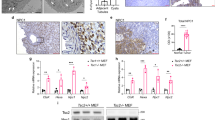Abstract
Mutations in the genes TSC1 or TSC2 cause the autosomal dominantly inherited tumor suppressor syndrome tuberous sclerosis, which is characterized by the development of tumors, named hamartomas, in different organs. The TSC gene products, hamartin and tuberin, form a complex, of which tuberin is assumed to be the functional component. Both, hamartin and tuberin have been implicated in the control of the cell cycle by activating the cyclin-dependent kinase inhibitor p27 and in cell size regulation by inhibiting the mammalian target of rapamycin (mTOR) a regulator of the p70 ribosomal protein S6 kinase (p70S6K) and its target the ribosomal protein S6. The tuberin/hamartin complex was shown to protect p27 from protein degradation. Within the mTOR signaling pathway tuberin harbors GTPase activating (GAP) potential toward Rheb, which is a potent regulator of mTOR. In this study, we have analyzed the protein levels of tuberin, p27, cyclin D1, mTOR and phospho mTOR Ser2448 (activated mTOR), S6 and phospho S6 Ser240/244 (activated S6) and as controls α-tubulin and topoisomerase IIβ, in ten different cells, including primary normal cells, immortalized and transformed cell lines.

Similar content being viewed by others
References
Astrinidis A, Henske EP (2005) Tuberous sclerosis complex: linking growth and energy signaling pathways with human disease. Oncogene 24:7475–7481
Besson A, Gurian-West M, Schmidt A, Hall A, Roberts JM (2004) p27Kip1 modulates cell migration through the regulation of RhoA activation. Genes Dev 18:862–876
Besson A, Hwang HC, Cicero S, Donovan SL, Gurian-West M, Johnson D, Clurman BE, Dyer MA, Roberts JM (2007) Discovery of an oncogenic activity in p27Kip1 that causes stem cell expansion and a multiple tumor phenotype. Genes Dev 21:1731–1746
Bhaskar PT, Hay N (2007) The two TORCs and Akt. Dev Cell 12:487–502
Blain SW, Scher HI, Cordon-Cardo C, Koff A (2003) p27 as a target for cancer therapeutics. Cancer Cell 3:111–115
Corradetti MN, Guan K-L (2006) Upstream of the mammalian target of rapamycin: do all roads pass through mTOR? Oncogene 25:6347–6360
Crino PB, Nathanson KL, Henske EP (2006) The tuberous sclerosis complex. New Engl J Med 355:1345–1356
Denicourt C, Saenz CC, Datnow B, Cui XS, Dowdy SF (2007) Relocalized p27Kip1 tumor suppressor functions as a cytoplasmic metastatic oncogene in melanoma. Cancer Res 67:9238–9243
Freilinger A, Rosner M, Hengstschläger M (2006a) Tuberin negatively affects BCL-2’s cell survival function. Amino Acids 30:391–396
Freilinger A, Rosner M, Krupitza G, Nishino M, Lubec G, Korsmeyer, Hengstschläger M (2006b) Tuberin activates the proapoptotic molecule BAD. Oncogene 25:6467–6479
Freilinger A, Rosner M, Hanneder M, Hengstschläger M (2008) Ras mediates cell survival by regulating tuberin. Oncogene. doi:10.1038/sj.onc.1210844
Guertin DA, Sabatini DM (2007) Defining the role of mTOR in cancer. Cancer Cell 12:9–22
Henry KW, Yuan X, Koszewski NJ, Onda H, Kwiatkowski DJ, Noonan DJ (1998) Tuberous sclerosis gene 2 product modulates transcription mediated by steroid hormone receptor family members. J Biol Chem 273:20535–20539
Inoki K, Zhu T, Guan K-L (2003) TSC2 mediates cellular energy response to control cell growth and survival. Cell 115:577–590
Manning BD, Cantley LC (2007) AKT/PKB signaling: navigating downstream. Cell 129:1261–1274
Miloloza A, Rosner M, Nellist M, Halley D, Bernaschek G, Hengstschläger M (2000) The TSC1 gene product, hamartin, negatively regulates cell proliferation. Hum Mol Genet 9:1721–1727
Musgrove EA (2006) Cyclins: roles in mitogenic signaling and oncogenic transformation. Growth Factors 24:13–19
Nho RS, Sheaff RJ (2003) p27kip1 contributes to cancer. Prog Cell Cycle Res 5:249–259
Pan D, Dong J, Zhang Y, Gao X (2004) Tuberous sclerosis complex: from Drosophila to human disease. Trends Cell Biol 14:78–85
Rosner M, Hengstschläger M (2004) Tuberin binds p27 and negatively regulates its interaction with the SCF component Skp2. J Biol Chem 279:48707–48715
Rosner M, Hengstschläger M (2007) Cytoplasmic/nuclear localization of tuberin in different cell lines. Amino Acids 33:575–579
Rosner M, Hofer K, Kubista M, Hengstschläger M (2003) Cell size regulation by the human TSC tumor suppressor proteins depends on PI3K and FKBP38. Oncogene 22:4786–4798
Rosner M, Freilinger A, Hengstschläger M (2004) Proteins interacting with the tuberous sclerosis gene products. Amino Acids 27:119–128
Rosner M, Freilinger A, Hanneder M, Fujita N, Lubec G, Tsuruo T, Hengstschläger M (2007a) p27 localization depends on the tumor suppressor protein tuberin. Hum Mol Genet 16:1541–1556
Rosner M, Freilinger A, Hengstschläger M (2007b) Akt regulates nuclear/cytoplasmic localization of tuberin. Oncogene 26:521–531
Rosner M, Hanneder M, Siegel N, Valli A, Hengstschläger M (2008) The tuberous sclerosis gene products hamartin and tuberin are multifunctional proteins with a wide spectrum of interacting partners. Mutat Res Rev Mutat Res. doi:10.1016/j.mmrev.2008.01.001
Shah OJ, Wang Z, Hunter T (2004) Inappropriate activation of the TSC/Rheb/mTOR/S6K cassette induces IRS1/2 depletion, insulin resistance, and cell survival deficiencies. Curr Biol 14:1650–1656
Sicinski P, Zacharek S, Kim C (2007) Duality of p27Kip1 function in tumorigenesis. Genes Dev 21:1703–1706
Soucek T, Pusch O, Wienecke R, DeClue JE, Hengstschläger M (1997) Role of the tuberous sclerosis gene-2 product in cell cycle control. J Biol Chem 272:29301–29308
Soucek T, Hölzl G, Bernaschek G, Hengstschläger M (1998a) A role of the tuberous sclerosis gene-2 product during neuronal differentiation. Oncogene 16:2197–2204
Soucek T, Yeung RS, Hengstschläger M (1998b) Inactivation of the cyclin-dependent kinase inhibitor p27 upon loss of the tuberous sclerosis complex gene-2. Proc Natl Acad Sci USA 95:15653–15658
The European Chromosome 16 Tuberous Sclerosis Consortium (1993) Identification and characterization of the tuberous sclerosis gene on chromosome 16. Cell 75:1305–1315
The TSC1 Consortium (1997) Identification of the tuberous sclerosis gene TSC1 on chromosome 9q34. Science 277:805–808
Wullschleger S, Loewith R, Hall MN (2006) TOR signaling in growth and metabolism. Cell 124:471–484
Xiao G-H, Shoarinejad F, Jin F, Golemis EA, Yeung RS (1997) The tuberous sclerosis 2 gene product, tuberin, functions as a Rab5 GTPase activating protein (GAP) in modulating endocytosis. J Biol Chem 272:6097–6100
Author information
Authors and Affiliations
Corresponding author
Additional information
S. Burgstaller and M. Rosner equally contributed to this study.




